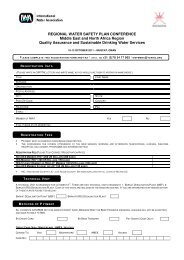Water safety in buildings - libdoc.who.int - World Health Organization
Water safety in buildings - libdoc.who.int - World Health Organization
Water safety in buildings - libdoc.who.int - World Health Organization
You also want an ePaper? Increase the reach of your titles
YUMPU automatically turns print PDFs into web optimized ePapers that Google loves.
Tables<br />
Table 4.1 Nomenclature of waters used <strong>in</strong> health-care build<strong>in</strong>gs <strong>in</strong> France ....... 35<br />
Table 4.2 Example of a simple risk-scor<strong>in</strong>g matrix for rank<strong>in</strong>g risks ................ 55<br />
Table 4.3 Examples of def<strong>in</strong>itions of likelihood and severity categories<br />
that can be used <strong>in</strong> risk scor<strong>in</strong>g ........................................................... 56<br />
Table 4.4 Examples of hazards, hazardous events and responses ...................... 73<br />
Table 5.1 Management legislation .................................................................... 104<br />
Table 5.2 Technical regulations ........................................................................ 105<br />
Table 5.3 L<strong>in</strong>ks between legislation, regulations and standards ...................... 107<br />
I Hazard identification, hazard assessment and risk characterization ...................111<br />
II Operational monitor<strong>in</strong>g and management ........................................................ 114<br />
Figures<br />
Figure 1.1 Framework for safe dr<strong>in</strong>k<strong>in</strong>g-water ...................................................... 2<br />
Figure 3.1 Roles and responsibilities for major projects or significant<br />
modifications ...................................................................................... 28<br />
Figure 3.2 Roles and responsibilities for exist<strong>in</strong>g <strong>in</strong>stallations ........................... 29<br />
Figure 3.3 Roles and responsibilities for surveillance and support<strong>in</strong>g<br />
requirements ....................................................................................... 30<br />
Figure 4.1 Summary of the steps <strong>in</strong>volved <strong>in</strong> develop<strong>in</strong>g a water <strong>safety</strong> plan .... 32<br />
Figure 4.2 Typical components of water systems <strong>in</strong>side build<strong>in</strong>gs ...................... 37<br />
Figure 4.3 Types of <strong>in</strong>formation to consider <strong>in</strong> risk assessment .......................... 54<br />
Boxes<br />
Box 4.1 Cryptosporidiosis associated with water shortage .............................. 39<br />
Box 4.2 Methaemoglob<strong>in</strong>emia attributable to nitrite contam<strong>in</strong>ation of<br />
potable water through boiler fluid additives, New Jersey, 1992<br />
and 1996 ............................................................................................. 40<br />
Box 4.3 Resolution of a Pseudomonas aerug<strong>in</strong>osa outbreak <strong>in</strong> a<br />
haematology unit with the use of disposable sterile water filters ....... 42<br />
Box 4.4 Def<strong>in</strong>itions of hazards, hazardous events and risk .............................. 43<br />
Box 4.5 <strong>Water</strong> quality at rural South African health-care facilities ................. 46<br />
Box 4.6 Poor management of a hospital water supply ..................................... 47<br />
Box 4.7 Outbreak of legionellosis due to failure <strong>in</strong> cold-water system ........... 49<br />
Contents vii



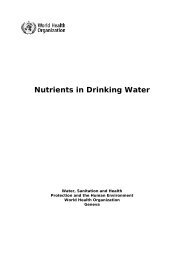
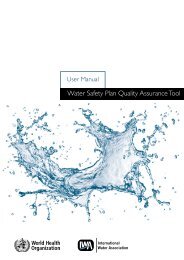

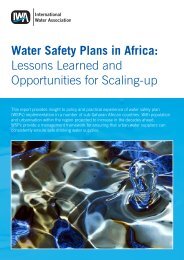

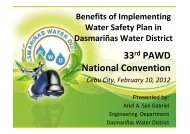
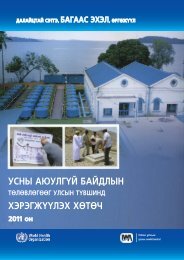

![Pdf [5.32 Mb] - Water Safety Portal](https://img.yumpu.com/32098467/1/190x245/pdf-532-mb-water-safety-portal.jpg?quality=85)
